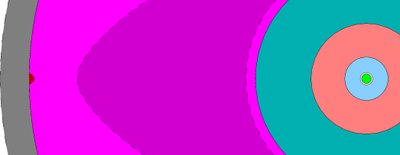Shaped charge
|
|
A shaped charge is an explosive charge shaped to focus the effect of the released energy. Various types are used to cut and form metal, initiate nuclear weapons, and penetrate armour. A typical modern shaped charge can penetrate armor steel to a depth of about 7 times the diameter of the charge.
A typical device consists of a solid cylinder of explosive with a conical hollow on one end, lined with a dense ductile metal such as copper. When detonated from the other end, the force of the explosive detonation wave is great enough to project the copper into a thin, effectively liquid, stretching jet having a tip speed of up to 12 km/s. The enormous pressures generated cause the target material to yield and flow plastically. A common misconception is that the penetration is a result of melting, but both jet and target usually remain in a solid state.
Shaped charges are frequently used as warheads in anti-tank missiles and mortar shells. They are used most numerously in the petroleum industry, in completing oil wells, by perforating the well casing at intervals to admit the influx of oil. Another important non-military use is to cut large pieces of metal in confined spaces, especially during rescues. They are also used to demolish large obsolete structures by precisely placed and progressively timed cutting charges with the intent of causing an inward collapse that confines the debris to the structure's footprint.
Design
There are several different forms of shaped charge.
Metal-cutting charges are flat triangles of plastic explosive (usually plastique). A blasting cap detonator is placed in the point of the triangle. The triangle is laid down with the wide end wrapped around the material to cut. When the blast reaches the end of the explosive, it is reflected into the metal, cutting it.
A scissors charge is two of the above triangular charges, placed on opposite sides of the metal, on opposite sides of the cutting line. They must be sized and timed so the blast wave of each arrives at the same time at the cutting line. The opposing blast waves shear the metal.
Differential cones transfer momentum from the explosive to another material, usually a metal such as copper, with a speed of sound different from the speed of the blast in the explosive. The slope of the cone is chosen so that the speed of the blast at the surface of the cone is equal to the speed of sound of the metal on the surface of the cone. The result is a hypersonic jet. This jet then penetrates the armour. This is also called the Munroe effect, discovered in 1888. This is the basis of high explosive anti-tank (HEAT) weapons.
Differential cones are easy to manufacture. Usually the penetrator cone is swaged to a casing, and the explosive is cast inside the resulting shape.
Explosive lenses are machined (usually) from an alloy of a rigid explosive with a compatible plastic. The surface of the lens is calculated to cause the blast front to go where desired. This is possible because the blast ignition in the explosive almost always moves at a different speed than the shockwave in the explosive reaction products. The term explosive lens is also used to denote explosive charges in which different portions of the charge are made with different high explosives that have significantly different detonation propagation velocities (such as Composition-B and 6040 Pentolite, or TNT and HMX) in a particular geometric arrangement and are constructed in such a manner that the different detonation speeds will work together to focus the force of the blast in a way that achieves a desired effect.
Some explosive lenses (notably those in nuclear weapons) use two different materials with different speeds of ignition. The illustration represents a cross section through a segment of a polygonal wedge. The wedges are fitted together to form a spherical object. The small initiator (similar to a blasting cap) at the left triggers a semi-spherical wave through the slow speed outer explosive. As the wave is transferred to the precision shaped inner explosive a new spherical wave - centered on the object - is formed. This is the implosive wave used to crush the inner parts to a critical mass. The successful operation of this device depends upon the simultaneous initiation of the wave in each segment, uniformity and precision in the speed of the wave, and correctness and accuracy in the shape of the interface between the two explosives.
Linear The explosive charge is covered by a liner, but in the shape of a flat plane.
Platter or the Misznay-Schardin effect (discovered in 1944)- A solid piece of metal, with a quantity of explosives placed on only one side or plane, an idea used in the Claymore mine.
External link
- Use of shaped charges and protection against them in WWII (http://www.geocities.com/Augusta/8172/panzerfaust1.htm)de:Hohlladung

